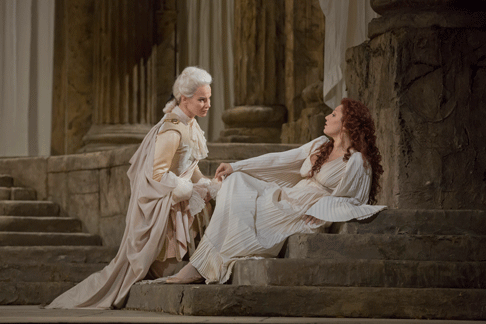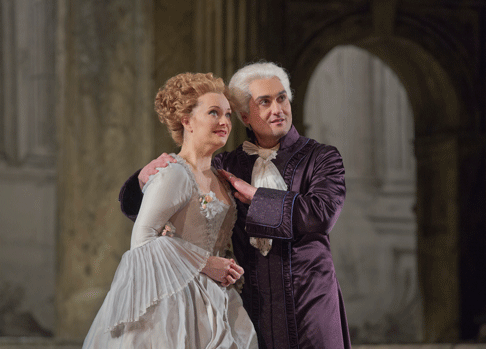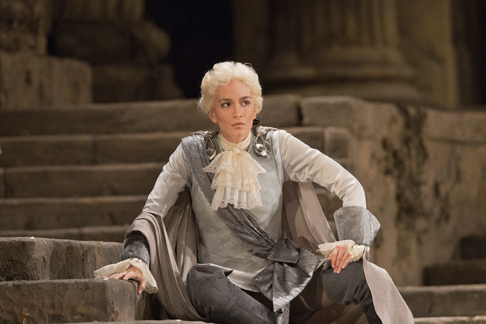![Elīna Garanča as Sesto [Photo by Ken Howard courtesy of The Metropolitan Opera]](http://www.operatoday.com/TITO_2151a.gif)
10 Dec 2012
The Met’s La Clemenza di Tito blends inspired singing with dazzling wind obbligatos
The live HD simulcast of Mozart’s final operatic effort, set in ancient Rome, reached friends, Romans and countrymen the world over
English Touring Opera are delighted to announce a season of lyric monodramas to tour nationally from October to December. The season features music for solo singer and piano by Argento, Britten, Tippett and Shostakovich with a bold and inventive approach to making opera during social distancing.
This tenth of ten Live from London concerts was in fact a recorded live performance from California. It was no less enjoyable for that, and it was also uplifting to learn that this wasn’t in fact the ‘last’ LfL event that we will be able to enjoy, courtesy of VOCES8 and their fellow vocal ensembles (more below …).
Ever since Wigmore Hall announced their superb series of autumn concerts, all streamed live and available free of charge, I’d been looking forward to this song recital by Ian Bostridge and Imogen Cooper.
Although Stile Antico’s programme article for their Live from London recital introduced their selection from the many treasures of the English Renaissance in the context of the theological debates and upheavals of the Tudor and Elizabethan years, their performance was more evocative of private chamber music than of public liturgy.
Evidently, face masks don’t stifle appreciative “Bravo!”s. And, reducing audience numbers doesn’t lower the volume of such acclamations. For, the audience at Wigmore Hall gave soprano Elizabeth Llewellyn and pianist Simon Lepper a greatly deserved warm reception and hearty response following this lunchtime recital of late-Romantic song.
For this week’s Live from London vocal recital we moved from the home of VOCES8, St Anne and St Agnes in the City of London, to Kings Place, where The Sixteen - who have been associate artists at the venue for some time - presented a programme of music and words bound together by the theme of ‘reflection’.
'Such is your divine Disposation that both you excellently understand, and royally entertaine the Exercise of Musicke.’
‘And there was war in heaven: Michael and his angels fought against the dragon; and the dragon fought and his angels, And prevailed not; neither was their place found any more in heaven … that old serpent … Satan, which deceiveth the whole world: he was cast out into the earth, and his angels were cast out with him.’
There was never any doubt that the fifth of the twelve Met Stars Live in Concert broadcasts was going to be a palpably intense and vivid event, as well as a musically stunning and theatrically enervating experience.
‘Love’ was the theme for this Live from London performance by Apollo5. Given the complexity and diversity of that human emotion, and Apollo5’s reputation for versatility and diverse repertoire, ranging from Renaissance choral music to jazz, from contemporary classical works to popular song, it was no surprise that their programme spanned 500 years and several musical styles.
The Academy of St Martin in the Fields have titled their autumn series of eight concerts - which are taking place at 5pm and 7.30pm on two Saturdays each month at their home venue in Trafalgar Square, and being filmed for streaming the following Thursday - ‘re:connect’.
The London Symphony Orchestra opened their Autumn 2020 season with a homage to Oliver Knussen, who died at the age of 66 in July 2018. The programme traced a national musical lineage through the twentieth century, from Britten to Knussen, on to Mark-Anthony Turnage, and entwining the LSO and Rattle too.
With the Live from London digital vocal festival entering the second half of the series, the festival’s host, VOCES8, returned to their home at St Annes and St Agnes in the City of London to present a sequence of ‘Choral Dances’ - vocal music inspired by dance, embracing diverse genres from the Renaissance madrigal to swing jazz.
Just a few unison string wriggles from the opening of Mozart’s overture to Le nozze di Figaro are enough to make any opera-lover perch on the edge of their seat, in excited anticipation of the drama in music to come, so there could be no other curtain-raiser for this Gala Concert at the Royal Opera House, the latest instalment from ‘their House’ to ‘our houses’.
"Before the ending of the day, creator of all things, we pray that, with your accustomed mercy, you may watch over us."
The doors at The Metropolitan Opera will not open to live audiences until 2021 at the earliest, and the likelihood of normal operatic life resuming in cities around the world looks but a distant dream at present. But, while we may not be invited from our homes into the opera house for some time yet, with its free daily screenings of past productions and its pay-per-view Met Stars Live in Concert series, the Met continues to bring opera into our homes.
Music-making at this year’s Grange Festival Opera may have fallen silent in June and July, but the country house and extensive grounds of The Grange provided an ideal setting for a weekend of twelve specially conceived ‘promenade’ performances encompassing music and dance.
There’s a “slide of harmony” and “all the bones leave your body at that moment and you collapse to the floor, it’s so extraordinary.”
“Music for a while, shall all your cares beguile.”
The hum of bees rising from myriad scented blooms; gentle strains of birdsong; the cheerful chatter of picnickers beside a still lake; decorous thwacks of leather on willow; song and music floating through the warm evening air.
![Elīna Garanča as Sesto [Photo by Ken Howard courtesy of The Metropolitan Opera]](http://www.operatoday.com/TITO_2151a.gif)
The live HD simulcast of Mozart’s final operatic effort, set in ancient Rome, reached friends, Romans and countrymen the world over
The Roman Emperor Titus was by all accounts a forgiving man. At least when compared to the likes of Caligula, Nero and Commodus. But even Titus (or Tito, as he’s known in this opera) would have been hard-pressed to find anything in need of a pardon at the Met’s handsomely sung and visually appealing production of Mozart’s La Clemenza di Tito.
A splendid cast of singers, led by the brilliant Latvian mezzo-soprano Elīna Garanĉa, included strong supporting efforts by Kate Lindsey and Lucy Crowe — as well as some outstanding efforts from the orchestra pit. Put it all together, and the Met’s revival of Jean-Pierre Ponnelle’s 1984 production, set in ancient Rome, is worthy of, well, lending an ear.
Mozart began working on his final opera soon after beginning Die Zauberflöte, and completed it in 18 days — an astounding feat, even making all allowances for his subcontracting out of the continuo-accompanied recitatives.
La Clemenza di Tito was commissioned in 1791 to commemorate the coronation of Austrian Emperor Leopold II as King of Bavaria. Mozart obliged by reaching back in time to the crusty old Italian opera seria style championed by Pietro Metastasio — the early 18th century librettist whose plots extolled the magnanimity of enlightened kings and emperors.
Mozart settled on a revision of the Metastasio’s libretto by Venetian poet Caterino Mazzola that afforded him greater flexibility in structuring the arias.
The plot focuses principally on first-century Roman Emperor Titus (Giuseppe Filianoti) and Vitellia (Barbara Frittoli), the self-centered and manipulative daughter of the former emperor usurped by Titus. Jealous of the emperor’s affections toward other women, Vitellia convinces her love-struck suitor Sesto (Elīna Garanĉa) to assassinate him, and Sesto obliges by settings the royal palace on fire in an unsuccessful attempt on the emperor’s life. Unaware of the conspiracy, Titus agrees to marry Vitellia — who realizes her good fortune will come at the expense of Sesto, now imprisoned for treason and prepared to face execution rather than implicate her. In the magnificent aria “Non più di fiori,” Vitellia wrestles with her conscience and ultimately admits complicity in the plot, hoping to save Sesto. Titus, displaying royal compassion endemic to all Metastasio protagonists, decides to forgive all. Long live the emperor. Long live Leopold II. (Applause.)
 Elīna Garanča as Sesto and Barbara Frittoli as Vitellia
Elīna Garanča as Sesto and Barbara Frittoli as Vitellia
Garanĉa, whom Met audiences no doubt remember as the title character in both Carmen and La Cenerentola, was in outstanding form in the “trousers role” of Emperor Titus’s confidante (and would-be assassin), Sesto. Here, she crafted a dramatically three-dimensional character torn between his genuine friendship for the emperor and his dysfunctional infatuation with the vengeful Vitellia.
Her signature aria “Parto, parto” revealed an agile vocal quality sufficiently nimble to weave up and down the scale in rapid triplets figures that were handsomely in-sync with the accomplished clarinet obbligato provided by Anthony McGill.
It was nevertheless Garanĉa’s lengthy second-act aria, “Deh per questo istante,” which proved the showstopper. This emotionally charged aria ranks among Mozart’s very best, and its relaxed and leisurely tempo left ample room for Garanĉa to lay bare her character’s soul, which she did to powerful effect.
When I last saw Barbara Frittoli as Micaëla in the Met’s 2010-2011 season production of Carmen I praised the Italian soprano’s formidable vocal skills, but added that her acting abilities left much to be desired. Judging from Saturday’s performance, little has changed. Void of any appreciable degree of meaningful facial expressions (and one cannot hide from the close-up camera work), Frittoli remained emotionally aloof from the complex character she portrayed.
Vitellia must undergo a complete about-face in this story — from a raging femme fatale to a contrite, conscious-stricken human being prepared to sacrifice everything in order to spare the love-struck but well-intentioned sucker she had duped into murder. It didn’t happen. Frittoli’s “Non più di fiori,” the lengthy aria where this transformation must take place, was well sung but dramatically and emotionally vacuous.
In the pants role of the young patrician, Annio, mezzo-soprano Kate Lindsey sang beautifully and her acting throughout the production was beyond reproach. The lustrous quality of Lindsey’s voice was evident in her every solo and ensemble number, but it was the degree of expression and nuance that left an indelible mark on the listener’s psyche. I especially enjoyed the profound intensity of Lindsey’s second act aria “Tu fosti tradito,” sung as her character mounts a stirring appeal to the emperor for mercy.
 Lucy Crowe as Servilia and Giuseppe Filianoti as Tito
Lucy Crowe as Servilia and Giuseppe Filianoti as Tito
It appears that Lindsey has carved a niche in “trouser roles” at the Met. In addition to Annio she has played Nicklausse (Les Contes d’Hoffmann) and Cherubino (Le Nozze di Figaro). But with or without pants, it’s clear that Lindsey is a first-rate singer-actress, with an ability to climb into any costume and fill every limb with body and substance.
In her Met production debut as Sesto’s sister, Servilia, English lyric soprano Lucy Crowe delivered “S’altro che lagrime” with such warmth and purity of tone I felt cheated that Mozart only allowed her character this single aria. The delicate quality to Crowe’s voice seems especially well suited to lieder, although it was clear from her delivery that she is capable of packing considerable power when needed. I eagerly await Crowe’s next role at the Met.
As the benevolent Emperor Tito, an impeccably attired Giuseppe Filianoti looked and acted well enough to qualify as the noblest Roman of them all. His pleasant sounding voice nevertheless appeared weak and shaky throughout much of the first act, beginning with the aria “Del più sublime soglio” — where the Italian lyric tenor’s middle register sounded raspy and his legato uneven.
Filianoti, who has battled the effects of a paralyzed vocal cord following the removal in 2007 of a cancerous thyroid gland, came alive in Act 2 with a much sturdier voice. He finished strongly in the second act “Se all’impero,” in spite of some difficulty keeping up with the orchestra during the 16th-note coloratura runs.
Ponnelle’s spacious period set, revealing a partially decaying interior of a huge palace in ancient Rome adorned with an array of imposing Corinthian columns, looked handsome from most every angle of Barbara Willis Sweete’s kaleidoscopic camerawork. Curiously, Ponnelle’s costumes appeared rooted in the 18th century — an anachronism suggesting perhaps that the director was trying to forge an artistic connection between “classical architecture” and “musical classicism.” Either that, or the Met costume department was running low on togas.
 Kate Lindsey as Annino
Kate Lindsey as Annino
English conductor and early music specialist Harry Bicket directed an alert Met Opera Orchestra that played with alacrity, even during the routine recitativo accompagnato sections. In addition to Anthony McGill’s flashy clarinet obbligato accompaniment in “Parto, parto,” James Ognibene deserves kudos for his dazzling basset horn obbligato in “Non più di fiori.” Ognibene’s liquid tone throughout the range of this tenor clarinet sounded as warm and focused as that of an A or B-flat soprano clarinet. (Both obbligato parts were tailored for Mozart’s close friend and fellow Freemason, Anton Stadler.)
It’s understandable why Clemenza fails to muster the universal level of interest enjoyed by the composer’s more popular Italian operas Le Nozze di Figaro, Cosi fan tutte and Don Giovanni: It simply is not as good. On the other hand, there’s much to love and admire about Mozart’s final opera, including signature arias such as “Deh per questo istante.” Perhaps the current Ponnelle production will reignite listener passion for this deserving work.
If not, we may be needing yet another pardon from Titus.
By David Abrams